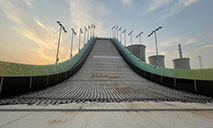Wang Dazhong: Leading scientist in China’s nuclear energy technologies
Wang Dazhong, an academician at the Chinese Academy of Sciences (CAS). (Photo/Website of Tsinghua University)
Wang Dazhong, an 86-year-old academician at the Chinese Academy of Sciences (CAS) and former president of Tsinghua University, won China’s top science award for his outstanding contributions to the research and development of advanced nuclear energy technologies at a grand ceremony held on Nov. 3 at the Great Hall of the People in Beijing to honor distinguished scientists, engineers, and research achievements.
At 9:35 a.m. on Sept. 12, the No.1 reactor of Shidaowan nuclear power plant in east China’s Shandong province, the world's first industrial-scale demonstration plant of the high-temperature gas-cooled reactor (HTGR) with the pebble-bed module, achieved the first criticality and the generating unit officially entered the state of "self-sustaining chain reaction." Wang was there to witness the historic moment.
HTGRs, globally known as the fourth-generation nuclear reactors, are believed to have broad development prospects for their inherent safety, versatility, and modular construction.
The industry widely recognizes the Shidaowan HTGR as one of the preferred types of fourth-generation nuclear reactors. Its success means that China has reached the advanced international level in advanced nuclear energy technologies mainly characterized by inherent safety.
Over the past more than six decades, Wang has led his team in blazing a trail for China in the field, turning the country from a latecomer to a leader in advanced nuclear energy technologies.
Starting from scratch, Wang and his colleagues built China's first self-developed shielded test reactor at Huyu village situated at the foot of the Yanshan Mountains in Beijing. The project involved 17 supply systems, several thousand machine parts and components, and 200,000 meters of pipelines, among other things.
The average age of the people selected for the design and construction of the project was 23.5 years, and no one in the team had studied abroad or seen a real nuclear reactor. They started from building engineering models and conducted designing and calculations with several dozen hand-cranked computers.
After six years, Tsinghua University's shielded test reactor, also China's first self-developed nuclear reactor, was completed. Meanwhile, Wang gradually grew into a team leader with practical experience in nuclear reactor projects.
In the early 1980s, when countries hadn't focused on safety in the research on nuclear reactors, Wang set his eyes on inherent safety and concentrated efforts on research into modular HTGR. Although the development of nuclear energy was at a low ebb globally, Wang's resolution to continue digging deep into the field wasn't shaken a bit.
He made three decisions then, i.e., to develop HTGR with the pebble-bed module, to follow a development path from small-scale experimental reactors to full-size industrial demonstration nuclear power plants, and to adhere to independent innovation, which has had a significant influence on the development direction of HTGR technologies in China and even the world.
In 1986, Wang and his team again started from the very beginning to develop a 10MW pebble-bed modular HTGR, which required more than 20,000 spherical fuel elements that must pass rigorous tests and could withstand a high temperature of 1,600 degrees Celsius. Five million such particles could be produced at a time by each furnace, and the fraction defective must be lower than two in 100,000.
"Breakthroughs in key technologies couldn't be achieved overnight," Wang said. His team, which started from basic research in the field, eventually mass produced more than 20,000 spherical fuel elements that reached an international advanced level in terms of quality.
In 2000, the construction of the world's first fourth-generation advanced nuclear energy system, 10MW HTGR, was completed at Tsinghua University. "Many of my colleagues have devoted almost all their life to the HTGR project," Wang sighed.
Realizing the significance of nuclear energy for China's energy supply and environmental protection, Wang proposed achieving the transition from experimental reactors to industrial-scale prototype reactors many years ago.
In 2006, China listed the HTGR demonstration project as one of its major science projects, aiming to lay a foundation for developing the fourth-generation nuclear power technologies by building a 200MW HTGR demonstration project.
The project is exactly the Shidaowan HTGR nuclear power plant demonstration project. It took researchers more than ten years to achieve the first criticality at the No.1 reactor of the nuclear power plant.
"China was the first country in the world to build a nuclear power plant using the fourth-generation nuclear power technologies," said Zhang Zuoyi, director of the Institute of Nuclear and New Energy Technology, Tsinghua University.
"China's exploration of the fourth-generation nuclear power technologies will contribute more 'green strength' to the efforts to optimize and upgrade energy structure and promote ecological and environmental protection and governance in China and even the world," said He Jiankun, an old colleague of Wang and also director of China's national expert committee on climate change.
 |
Photos
Related Stories
- Suspension of China-Britain nuclear energy cooperation will hurt Britain's interests: embassy
- Xi, Putin witness launch of joint nuclear energy project, high-quality China-Russia cooperation boosted
- Xi, Putin to witness opening of nuclear energy cooperation project via video link
- Nuclear energy plays irreplaceable role in combating climate change: Chinese delegate
- Nuclear efforts see renewed momentum
Copyright © 2021 People's Daily Online. All Rights Reserved.











